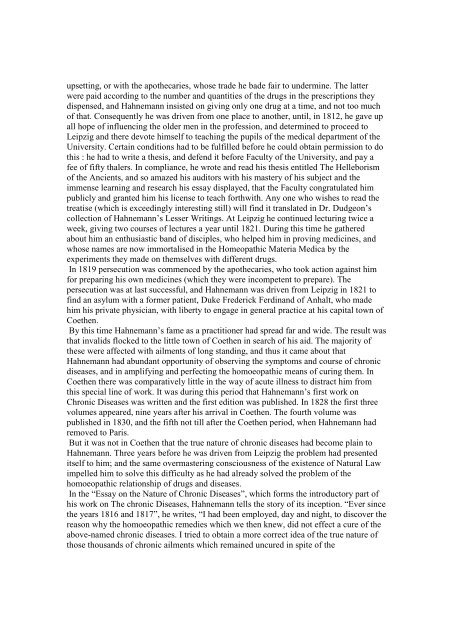CLARKE JH, Homoeopathy Explained - Classical Homeopathy Online
CLARKE JH, Homoeopathy Explained - Classical Homeopathy Online
CLARKE JH, Homoeopathy Explained - Classical Homeopathy Online
You also want an ePaper? Increase the reach of your titles
YUMPU automatically turns print PDFs into web optimized ePapers that Google loves.
upsetting, or with the apothecaries, whose trade he bade fair to undermine. The latter<br />
were paid according to the number and quantities of the drugs in the prescriptions they<br />
dispensed, and Hahnemann insisted on giving only one drug at a time, and not too much<br />
of that. Consequently he was driven from one place to another, until, in 1812, he gave up<br />
all hope of influencing the older men in the profession, and determined to proceed to<br />
Leipzig and there devote himself to teaching the pupils of the medical department of the<br />
University. Certain conditions had to be fulfilled before he could obtain permission to do<br />
this : he had to write a thesis, and defend it before Faculty of the University, and pay a<br />
fee of fifty thalers. In compliance, he wrote and read his thesis entitled The Helleborism<br />
of the Ancients, and so amazed his auditors with his mastery of his subject and the<br />
immense learning and research his essay displayed, that the Faculty congratulated him<br />
publicly and granted him his license to teach forthwith. Any one who wishes to read the<br />
treatise (which is exceedingly interesting still) will find it translated in Dr. Dudgeon’s<br />
collection of Hahnemann’s Lesser Writings. At Leipzig he continued lecturing twice a<br />
week, giving two courses of lectures a year until 1821. During this time he gathered<br />
about him an enthusiastic band of disciples, who helped him in proving medicines, and<br />
whose names are now immortalised in the Homeopathic Materia Medica by the<br />
experiments they made on themselves with different drugs.<br />
In 1819 persecution was commenced by the apothecaries, who took action against him<br />
for preparing his own medicines (which they were incompetent to prepare). The<br />
persecution was at last successful, and Hahnemann was driven from Leipzig in 1821 to<br />
find an asylum with a former patient, Duke Frederick Ferdinand of Anhalt, who made<br />
him his private physician, with liberty to engage in general practice at his capital town of<br />
Coethen.<br />
By this time Hahnemann’s fame as a practitioner had spread far and wide. The result was<br />
that invalids flocked to the little town of Coethen in search of his aid. The majority of<br />
these were affected with ailments of long standing, and thus it came about that<br />
Hahnemann had abundant opportunity of observing the symptoms and course of chronic<br />
diseases, and in amplifying and perfecting the homoeopathic means of curing them. In<br />
Coethen there was comparatively little in the way of acute illness to distract him from<br />
this special line of work. It was during this period that Hahnemann’s first work on<br />
Chronic Diseases was written and the first edition was published. In 1828 the first three<br />
volumes appeared, nine years after his arrival in Coethen. The fourth volume was<br />
published in 1830, and the fifth not till after the Coethen period, when Hahnemann had<br />
removed to Paris.<br />
But it was not in Coethen that the true nature of chronic diseases had become plain to<br />
Hahnemann. Three years before he was driven from Leipzig the problem had presented<br />
itself to him; and the same overmastering consciousness of the existence of Natural Law<br />
impelled him to solve this difficulty as he had already solved the problem of the<br />
homoeopathic relationship of drugs and diseases.<br />
In the “Essay on the Nature of Chronic Diseases”, which forms the introductory part of<br />
his work on The chronic Diseases, Hahnemann tells the story of its inception. “Ever since<br />
the years 1816 and 1817”, he writes, “I had been employed, day and night, to discover the<br />
reason why the homoeopathic remedies which we then knew, did not effect a cure of the<br />
above-named chronic diseases. I tried to obtain a more correct idea of the true nature of<br />
those thousands of chronic ailments which remained uncured in spite of the
















